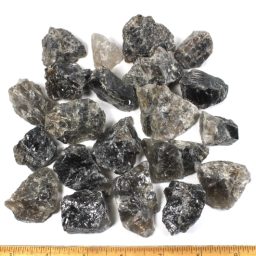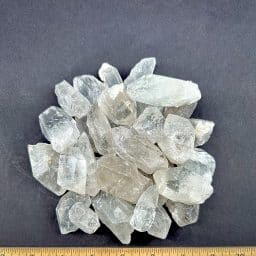Description
Mahogany Obsidian is a type of volcanic glass that is formed during the cooling and solidification of molten lava. It belongs to the broader category of obsidian, which is a naturally occurring glass with a smooth, glossy texture. What sets Mahogany Obsidian apart is its distinctive coloration, characterized by rich, deep brown and reddish-brown hues.
Geological Formation
Mahogany Obsidian, like all types of obsidian, is formed through the rapid cooling of volcanic lava. Here is a step-by-step explanation of the geological formation process:
Volcanic Activity: The process begins with volcanic activity, where molten lava erupts from the Earth’s mantle and reaches the surface. This lava is extremely hot, and as it flows, it begins to cool.
Rapid Cooling: Mahogany Obsidian is formed when the lava cools rapidly, preventing the crystalline structure from forming. Unlike slower-cooling igneous rocks, such as granite, which allows minerals to arrange in larger crystals, obsidian cools so quickly that crystals do not have time to grow.
Lack of Crystal Structure: The rapid cooling results in the lack of a defined crystal structure, giving obsidian its glassy and amorphous texture. The absence of crystalline boundaries contributes to the smooth and often glossy appearance of Mahogany Obsidian.
Mineral Impurities: The distinctive coloration of Mahogany Obsidian is due to the presence of mineral impurities, particularly iron and manganese. These impurities impart the reddish-brown and mahogany-like hues to the obsidian.
Formation of Inclusions: Sometimes, gas bubbles or other materials may become trapped during the rapid cooling process, forming inclusions within the obsidian. These inclusions can add further interest and uniqueness to the appearance of Mahogany Obsidian.
The geological process behind Mahogany Obsidian’s formation is part of the broader cycle of rock formation known as the rock cycle, where rocks undergo various processes such as melting, cooling, and solidification, eventually leading to the creation of new rocks. In the case of obsidian, its rapid formation during volcanic activity results in its distinct characteristics, making it a sought-after material for both geological study and decorative purposes.
Physical Properties
Mahogany Obsidian, being a type of obsidian, shares several physical properties with other varieties of this volcanic glass. Here are some of the key physical properties of Mahogany Obsidian:
Color: Mahogany Obsidian is characterized by its rich, deep brown and reddish-brown hues, resembling the color of mahogany wood. This distinctive coloration is due to the presence of iron and manganese impurities.
Luster: Obsidian, including Mahogany Obsidian, typically exhibits a vitreous or glassy luster. This gives the surface a smooth and shiny appearance.
Texture: It has a smooth and often glossy texture. The lack of a crystalline structure, which is common in other types of rocks, contributes to its glassy feel.
Hardness: Obsidian has a hardness of around 5 to 5.5 on the Mohs scale. This makes it relatively easy to scratch compared to harder minerals like quartz.
Transparency: Mahogany Obsidian is generally opaque, meaning that light does not pass through it. Its opacity is due to its amorphous (non-crystalline) structure.
Density: The density of Mahogany Obsidian is influenced by its composition, including the presence of impurities. Obsidian, in general, has a density ranging from 2.35 to 2.45 g/cm³.
Cleavage and Fracture: Obsidian does not exhibit cleavage, and its fracture is typically conchoidal. Conchoidal fracture results in smooth, curved surfaces that resemble the inside of a clamshell. This property is a result of the way obsidian breaks along curved surfaces, creating sharp edges.
Inclusions: Mahogany Obsidian, like other types of obsidian, may contain inclusions such as gas bubbles or mineral crystals trapped during its rapid cooling. These inclusions can contribute to its visual interest.
Historical and Cultural Significance
Obsidian, including Mahogany Obsidian, has held cultural and historical significance for various societies throughout human history. Here are some aspects of its cultural and historical importance:
Toolmaking: Obsidian has been used by many ancient cultures for making tools and weapons due to its sharp edges when fractured. The conchoidal fracture of obsidian produces razor-like edges that were highly valued for cutting and piercing. Archaeological evidence shows that obsidian tools were used by early human societies, such as the production of arrowheads and blades.
Ceremonial and Decorative Use: Mahogany Obsidian, with its unique coloration, has often been incorporated into ceremonial and decorative objects. It has been used in the creation of jewelry, amulets, and other ornamental items. The cultural significance of these items may vary among different societies, often being associated with spirituality, protection, or social status.
Cultural Artifacts: Archaeological findings indicate that obsidian was traded over long distances in ancient times. The movement of obsidian artifacts has been used by researchers to trace ancient trade routes and connections between different cultures. The presence of obsidian artifacts in certain regions can provide insights into prehistoric exchange networks.
Symbolic Meanings: In some cultures, the deep colors of Mahogany Obsidian may hold symbolic meanings. For example, the reddish-brown hues may be associated with the earth, blood, or other elements depending on cultural beliefs.
Historical Trade: Obsidian was a valuable trade commodity in various ancient societies. The flow of obsidian across regions served as a form of early commerce, and the presence of obsidian artifacts has been used by archaeologists to study ancient trade patterns and connections.
Art and Craftsmanship: The unique appearance of Mahogany Obsidian makes it a desirable material for artists and craftsmen. Its use in sculptures, carvings, and other artistic creations highlights its aesthetic appeal and cultural importance in the realm of art.
While the specific cultural and historical significance of Mahogany Obsidian can vary across different civilizations and regions, its role in toolmaking, adornment, and spiritual practices has left a lasting impact on human history. Today, it continues to be appreciated for its beauty and is used in various forms of art and personal adornment.
Uses
Jewelry: Mahogany Obsidian’s unique coloration, smooth texture, and glossy luster make it a popular choice for jewelry. It is often used in the creation of beads, pendants, and cabochons for necklaces, bracelets, earrings, and other accessories.
Ornamental Objects: The attractive appearance of Mahogany Obsidian makes it suitable for ornamental objects. Carvings, sculptures, and figurines crafted from Mahogany Obsidian can be used for decorative purposes in homes or as collectible art pieces.
Metaphysical and Spiritual Practices: Mahogany Obsidian, like many other crystals and gemstones, is believed by some to possess metaphysical properties. It is often used in spiritual practices, energy work, and crystal healing. Some people associate Mahogany Obsidian with grounding energy, protection, and the absorption of negative influences.
Lapidary Arts: Lapidary artists and craftsmen use Mahogany Obsidian for cutting and shaping into various forms. The glassy texture and unique colors make it a desirable material for creating aesthetically pleasing lapidary pieces.
Cultural and Ritual Objects: In some cultures, Mahogany Obsidian may be incorporated into cultural or ritual objects, such as amulets, totems, or ceremonial tools. The stone’s color and perceived properties may hold symbolic significance in certain traditions.
Historical Reproductions: Due to its similarity to historically significant materials, Mahogany Obsidian may be used in the reproduction of historical artifacts. Craftsmen and artisans may recreate tools or decorative items reminiscent of those used by ancient cultures.
Display Specimens: Mahogany Obsidian specimens with particularly striking patterns, colors, or inclusions may be collected and displayed for educational or aesthetic purposes. Museums, educational institutions, and private collectors may appreciate the unique geological features of Mahogany Obsidian.
Trade and Commerce: Historically, obsidian, including Mahogany Obsidian, has been used as a trade commodity. Its use in tools and weapons made it a valuable resource for ancient cultures, and the movement of obsidian artifacts has been studied by archaeologists to understand ancient trade routes.
It’s important to note that while Mahogany Obsidian has cultural and historical significance,












